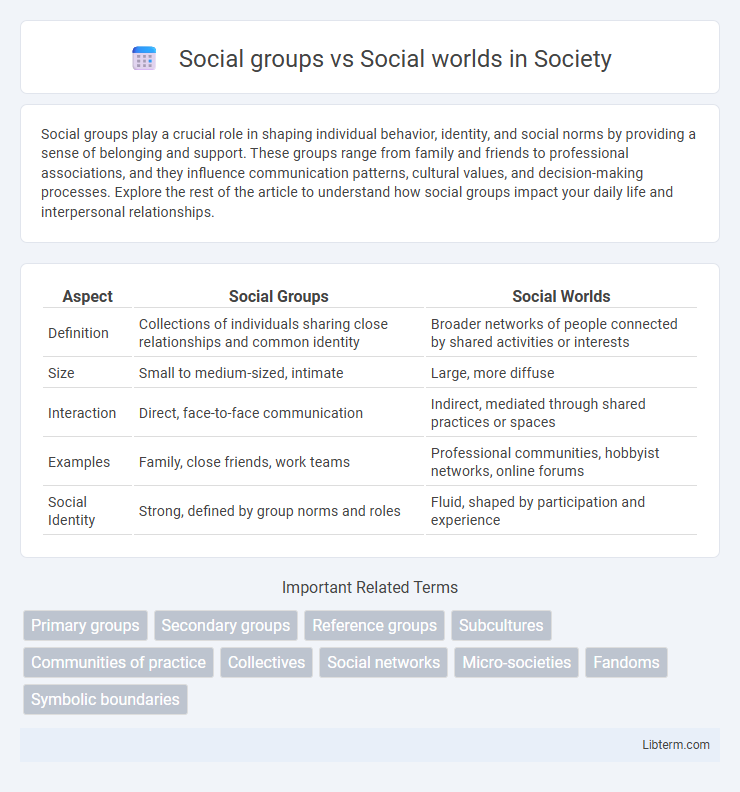Social groups play a crucial role in shaping individual behavior, identity, and social norms by providing a sense of belonging and support. These groups range from family and friends to professional associations, and they influence communication patterns, cultural values, and decision-making processes. Explore the rest of the article to understand how social groups impact your daily life and interpersonal relationships.
Table of Comparison
| Aspect | Social Groups | Social Worlds |
|---|---|---|
| Definition | Collections of individuals sharing close relationships and common identity | Broader networks of people connected by shared activities or interests |
| Size | Small to medium-sized, intimate | Large, more diffuse |
| Interaction | Direct, face-to-face communication | Indirect, mediated through shared practices or spaces |
| Examples | Family, close friends, work teams | Professional communities, hobbyist networks, online forums |
| Social Identity | Strong, defined by group norms and roles | Fluid, shaped by participation and experience |
Introduction to Social Groups and Social Worlds
Social groups consist of individuals connected through shared interests, goals, or identities, forming structured interactions and collective identities. Social worlds encompass overlapping and intersecting social groups that create broader, dynamic cultural or institutional environments shaped by continuous social processes. Understanding social groups provides foundational insights into the micro-level relationships, while social worlds highlight the complexity of macro-level social interactions and cultural formations.
Defining Social Groups: Core Characteristics
Social groups are defined by shared characteristics such as stable membership, structured interactions, and common goals or norms that create a sense of belonging among members. These core features distinguish social groups from social worlds, which are broader, more fluid cultural contexts encompassing diverse roles and activities without necessarily requiring direct interaction. Understanding social groups involves analyzing patterns of social cohesion, roles, and collective identity that influence behavior and group dynamics within the social environment.
Understanding Social Worlds: Key Features
Social worlds consist of interconnected social groups sharing common interests, practices, and languages, creating dynamic contexts for social interaction and identity formation. Key features include fluid boundaries, overlapping memberships, and shared meanings that evolve through ongoing communication and negotiation. Understanding social worlds involves analyzing how these elements shape collective behavior and influence individual roles within complex social environments.
Differences Between Social Groups and Social Worlds
Social groups consist of individuals who share direct interactions and a sense of belonging, typically united by common interests or goals. Social worlds encompass broader networks of shared understandings, norms, and practices that extend beyond immediate interactions, often including multiple overlapping social groups. The key difference lies in social groups being relatively smaller and more tangible, while social worlds represent larger, more abstract cultural and social contexts.
The Structure of Social Groups
The structure of social groups is defined by shared norms, roles, and interaction patterns among members who maintain a sense of unity and identity. Social worlds extend beyond groups by encompassing multiple overlapping networks, activities, and interests that create complex cultural and social environments. Understanding social groups highlights bounded membership and direct relationships, while social worlds emphasize fluid boundaries and collective participation across various social contexts.
Dynamics Within Social Worlds
Social worlds consist of interconnected social groups sharing common activities, language, or interests, creating a dynamic network of relationships and interactions. Within social worlds, members negotiate meanings, roles, and boundaries, leading to continual shifts in group norms and social structures. This fluidity fosters adaptability and innovation, as individuals and groups respond to internal conflicts and external influences.
Social Identity in Groups vs Social Worlds
Social identity within social groups is defined by shared norms, roles, and interpersonal bonds that foster a sense of belonging and collective self-concept. Social worlds encompass broader, dynamic cultural arenas where multiple groups interact, negotiate meanings, and continuously reshape identities and social boundaries. Understanding social identity requires examining how individuals align with specific groups while simultaneously navigating the overlapping social worlds that influence their behaviors and self-perceptions.
Influence on Individual Behavior
Social groups exert direct influence on individual behavior through established norms, roles, and expectations that guide interactions and decision-making. Social worlds shape behavior more broadly by providing overarching contexts, cultural meanings, and shared beliefs that define individuals' identities and perceptions within larger societal frameworks. Understanding the distinction between immediate social group pressures and the expansive influence of social worlds is crucial for analyzing behavioral patterns and social dynamics.
Real-Life Examples of Social Groups and Social Worlds
Social groups are collections of individuals bound by direct interaction and shared identities, such as a family unit or a workplace team where members communicate regularly. Social worlds encompass broader, more fluid networks united by common activities or interests, exemplified by online gaming communities or music festival attendees who may not interact personally but share a collective cultural experience. Real-life examples illustrate social groups as tight-knit units with face-to-face relationships, while social worlds represent expansive, overlapping spheres defined by shared practices and symbols.
Conclusion: Navigating Social Organizations
Social groups consist of individuals connected by shared interests, roles, or identities, forming cohesive units with clear boundaries. Social worlds encompass overlapping social contexts and cultural spaces where multiple groups interact and negotiate meaning. Navigating social organizations requires understanding the fluid dynamics between stable group structures and the broader, evolving social worlds they inhabit.
Social groups Infographic

 libterm.com
libterm.com